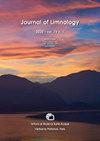The Recent non-marine ostracods of Tunisia: an updated checklist with remarks on their regional distribution patterns and ecological preferences
IF 1.1
4区 环境科学与生态学
Q4 LIMNOLOGY
引用次数: 3
Abstract
Different lines of investigation have recently contributed to increasing the available knowledge about the invertebrates inhabiting inland waters of north Africa, but a comprehensive synopsis on Tunisian Ostracoda is missing to date. An updated checklist of Recent non-marine ostracods from Tunisia and data on their distribution is thus offered here, representing the most extensive survey on this crustacean group ever carried out in inland waters throughout the country. One-hundred-five sites covering various climate zones, from Mediterranean to desert areas, were sampled between 2002 and 2012. Most of the considered water bodies were temporary or ephemeral habitats, but a few permanent sites were sampled as well. Overall, 18 genera and 32 taxa of putative species rank were collected in the frame of this survey, among which nine species and five genera were new to Tunisian fauna. As a result of this study and based on previous investigations, nine families (Candonidae, Cyprididae, Cytherideidae, Darwinulidae, Ilyocyprididae, Leptocytheridae, Limnocytheridae, Loxoconchidae, Paradoxostomatidae), 29 genera and at least 45 species of non-marine ostracods are currently known for Tunisia, which thus prove to host the most diverse ostracod fauna among north African countries. The number of species occurring in a single sample varied from 1 to 4. The Eucypris virens complex was the most widespread taxon (58 records), followed by Heterocypris barbara (30 records), Heterocypris incongruens (22 records), and Sarscypridopsis aculeata (16 records). For some ostracod species, clear distributional gradients associated with different climatic conditions were observed. The affinities with adjacent Maghrebian ostracod faunas are discussed. This study confirms the crucial role played by marginal aquatic habitats for the conservation of biodiversity, in particular in arid and semi-arid regions.突尼斯新近的非海洋介形类:一份附有其区域分布模式和生态偏好注释的最新核对表
最近,不同的调查路线有助于增加人们对居住在北非内陆水域的无脊椎动物的了解,但迄今为止,突尼斯介形虫的全面简介还缺失。因此,这里提供了突尼斯最近非海洋介形虫的最新清单及其分布数据,这是有史以来在全国内陆水域对该甲壳类动物群进行的最广泛的调查。2002年至2012年间,对105个覆盖从地中海到沙漠地区的不同气候区的地点进行了采样。大多数被考虑的水体都是临时或短暂的栖息地,但也有一些永久性的地点被采样。总体而言,在本次调查的框架内,共收集了18个属和32个假定物种等级的分类群,其中9个属和5个属是突尼斯动物群的新物种。根据这项研究和之前的调查,突尼斯目前已知9科(Candonidae、Cyrididae、Cytherideidae、Darwinulidae、Ilyocypididae、Leptocyteheridae、Limnocytheridae、Loxoconchaidae、Paradostomatidae)、29属和至少45种非海洋介形虫,因此证明这些介形虫是北非国家中最具多样性的介形虫动物群。单个样本中出现的物种数量从1到4不等。病毒真星介复合体是分布最广的分类单元(58个记录),其次是野蛮异星介(30个记录)、不协调异星介和尖脊肉介(16个记录)。对于一些介形虫物种,观察到与不同气候条件相关的明显分布梯度。讨论了与相邻的马格里布介形目动物群的亲缘关系。这项研究证实了边缘水生栖息地在保护生物多样性方面发挥的关键作用,特别是在干旱和半干旱地区。
本文章由计算机程序翻译,如有差异,请以英文原文为准。
求助全文
约1分钟内获得全文
求助全文
来源期刊

Journal of Limnology
地学-湖沼学
CiteScore
2.70
自引率
6.20%
发文量
12
审稿时长
3 months
期刊介绍:
The Journal of Limnology publishes peer-reviewed original papers, review papers and notes about all aspects of limnology. The scope of the Journal of Limnology comprises the ecology, biology, microbiology, physics, and chemistry of freshwaters, including the impact of human activities, management and conservation. Coverage includes molecular-, organism-, community-, and ecosystem-level studies on both applied and theoretical issues. Proceedings of workshops, specialized symposia, conferences, may also be accepted for publication.
 求助内容:
求助内容: 应助结果提醒方式:
应助结果提醒方式:


